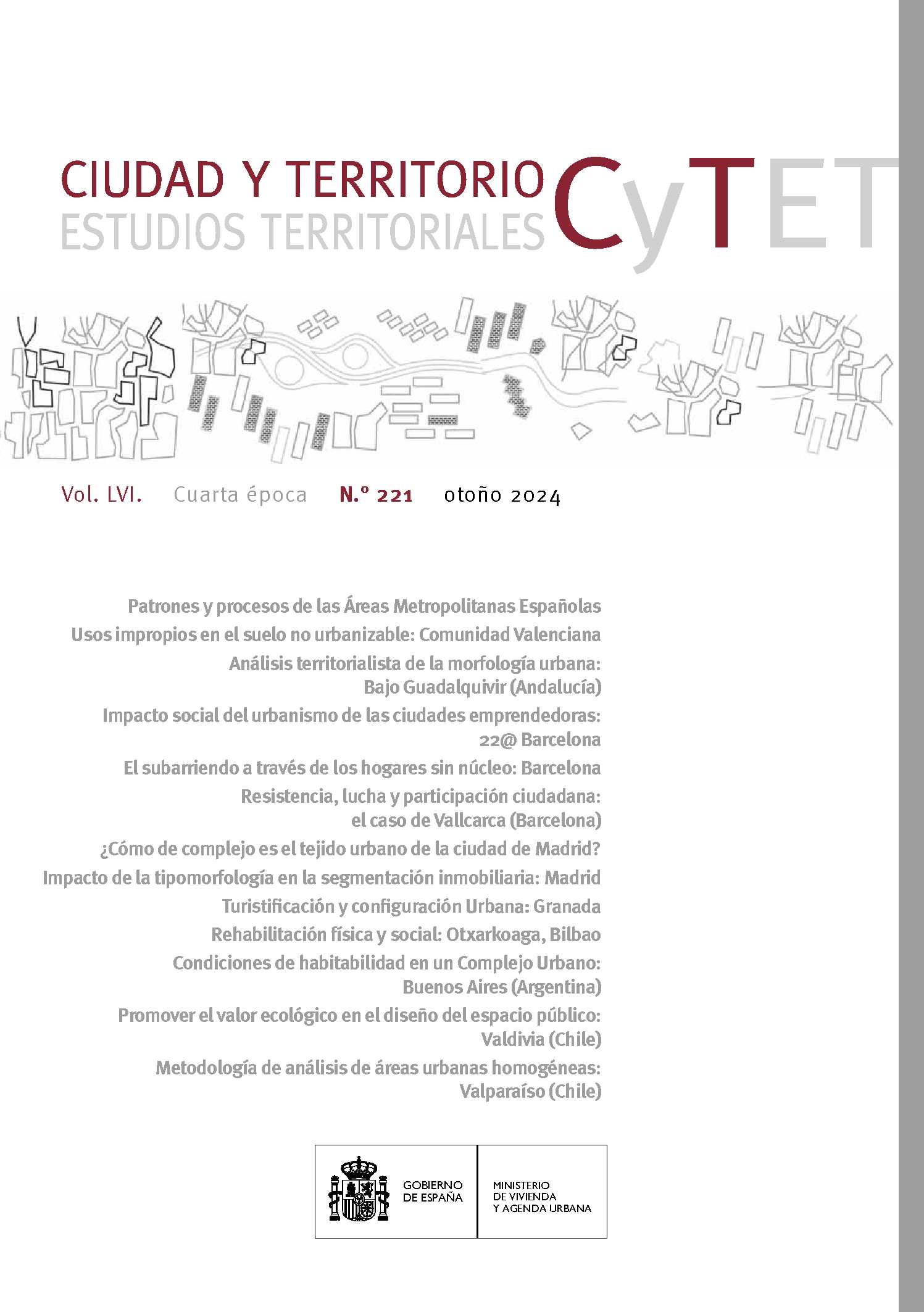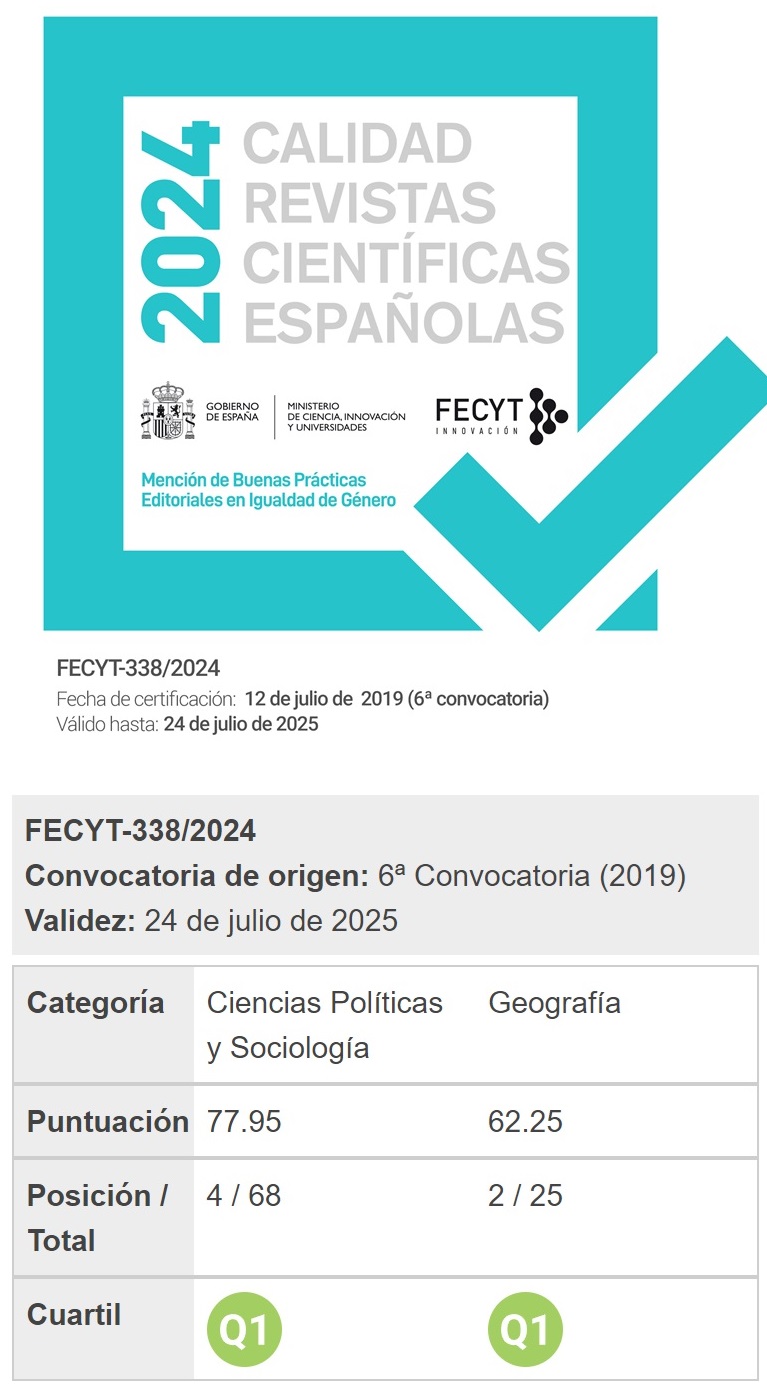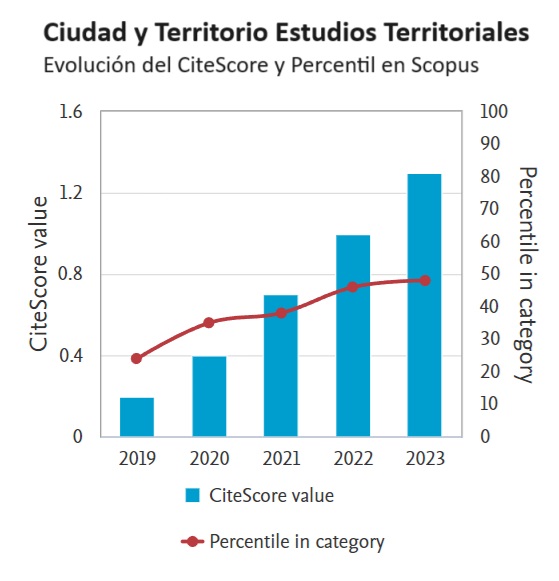Promover el aumento del valor ecológico en el diseño de espacios públicos: posibilidades en el caso de las riberas de Valdivia, Chile
DOI:
https://doi.org/10.37230/CyTET.2024.221.12Palabras clave:
Evaluación ecológica, Diseño urbano, Espacio público, Ríos urbanos, Naturaleza urbanaResumen
Frente al desafío contemporáneo del diseño de soluciones urbanas basadas en la naturaleza, nos enfrentamos a la pregunta de cómo conciliar los objetivos de protección de ecosistemas naturales con los intereses de seguridad, accesibilidad, legibilidad y sociabilidad en los espacios públicos. Se postula que el diseño del espacio público incide en la conservación de la biodiversidad, siendo relevante cuando este se encuentra al interior de áreas urbanas consolidadas, como es el caso de los ríos urbanos de la ciudad de Valdivia. A partir de una evaluación multicriterio, esta investigación busca entregar recomendaciones sobre los factores y criterios que propician una relación doblemente benéfica, tanto para la sociedad como para el medioambiente en zonas de borde río.
Descargas
Citas
ADAMS, S. & SAVAHL, S. (2017): Nature as children's space: A systematic review. The Journal of Environmental Education, 48(5), 291–321. https://doi.org/10.1080/00958964.2017.1366160
ADÁN, L. (2014): Los Reche-Mapuche a través de su sistema de asentamiento (siglos XV-XVII). Tesis para optar al grado de Doctora de Historia, mención Etnohistoria, Departamento de Ciencias Históricas, Universidad de Chile, Santiago.
AL SAYED, K. & TURNER, A. & HILLIER, B. & IIDA, S. & PENN, A. (2014): Space Syntax Methodology. (4th Edition). Bartlett School of Architecture, UCL.
ALEXANDER, C. (1979): The Timeless Way of Building; Oxford University Press: New York, NY, USA
ALEXANDER, C. & ISHIKAWA, S. & SILVERSTEIN, M. (1977): A Pattern Language: Towns, Buildings, Construction. Oxford University Press, New York
ARZATE, M. & ARZATE, G. (2020): El espacio público y su vínculo con el medio ambiente y el desarrollo sostenible. Revista Diseño Urbano & Paisaje - DU&P N°37. Pp. 9-14
ANDERSEN CIRERA, K. (2022): Spatial equity in river access. Measuring the public space potential of urban riverbanks in Valdivia, Chile. International Journal of Sustainable Development and Planning, Vol. 17, No. 1, pp. 1-12. https://doi.org/10.18280/ijsdp.170101
ANDERSEN CIRERA, K. LEHNER, D. & ZUMELZU SCHEEL, A. & MÉNDEZ SANHUEZA, P. (2019): Una metodología para evaluar los usos públicos y la percepción de los bordes fluviales: Valdivia como caso de estudio. Urbano, 22(40),28-39. [27 de Octubre de 2022]. ISSN: 0717-3997. https://www.redalyc.org/articulo.oa?id=19864321003
ANDERSEN CIRERA, K. & BALBONTÍN GALLO, C., (2021): La planificación del borde costero chileno. Una normativa deficiente. Revista de geografía Norte Grande, (80), 227-247. https://dx.doi.org/10.4067/S0718-34022021000300227
BALLOUCHE, A. & LONGUET,I. & VERDELLI, L. & WANTZEN, K.M. (2015): Introduction. La diversité des paysages fluviaux – enjeux scientifiques, d’aménagement et de gestion ». Norois N° 237, 2015/4, p.7-13
BOLUND, P. & HUNHAMMAR, S. (1999): Ecosystem Services in Urban Areas. Ecological Economics, 29, 293-301. http://dx.doi.org/10.1016/S0921-8009(99)00013-0
BORJA, J. & MUXI, Z. (2003): El espacio público, ciudad y ciudadanía. Editores: Barcelona: Electa.
BRATMAN, GN- & HAMILTON, JP. & DAILY, GC. (2012): The impacts of nature experience on human cognitive function and mental health. Annals of the New York Academy of Science, 1249:118-36. http://dx.doi.org/10.1111/j.1749-6632.2011.06400.x
BUNN, SE. & DAVIES, PM- & MOSISCH, TD. (1999): Ecosystem measures of river health and their response to riparian and catchment degradation. Freshwater Biology41: 333–345.
CARRASCO, S. & HAUENSTEIN, E. & PEÑA-CORTÉS, F. & BERTRÁN, C. & TAPIA, J. & VARGAS-CHACOFF, L. (2014): Evaluación de la calidad de vegetación ribereña en dos cuencas costeras del sur de Chile mediante la aplicación del índice QBR, como base para su planificación y gestión territorial. Gayana Bot. 71(1):1-9
CASAKIN, H. 2018. “The Use of Patterns as an Urban Design Approach”. Urban Science .2, 101; http://dx.doi.org/10.3390/urbansci2040101
CASTONGUAY, S. & EVEDEN, M. (2012): Urban Rivers: Re-making Cities, Rivers and Space in Europe and North America. U Pittsburgh Press.
CENTRO DE ESTUDIOS AGRARIOS Y AMBIENTALES, CEA (2010): Identificación de áreas potenciales para establecer reservas destinadas a proteger la fauna nativa de especies hidrobiológicas de agua dulce. Informe Final, Valdivia.
CHE, Y. & YANG, K. & CHEN, T. & XU, Q. (2012): Assessing a riverfront rehabilitation project using the comprehensive index of public accessibility, Ecological Engineering, 40, 80-87. https://doi.org/10.1016/j.ecoleng.2011.12.008
CORDELL, H. K. & MURPHY, D. & RIITTERS, K. H. & HARVARD, J.E., III. (2005): The natural ecological value of wilderness. In: The Multiple Values of Wilderness: 205-249
DE GROOT, R.S. & ALKEMADE, R. & BRAAT, L. & HEIN, L. & WILLEMEN, L., (2010): Challenges in integrating the concept of ecosystem services and values in landscape planning, management and decision making. Ecological Complexity, Volume 7, Issue 3, Pages 260-272, ISSN 1476-945X
DÍAZ, I. & CHÁVEZ, C. & GODOY-GÜINAO, J. (2018): Historia natural y uso del hábitat de las aves de paisajes urbanos en Santiago y Valdivia. En Biodiversidad urbana en Chile: estado del arte y los desafíos futuro”s. Cap. 9:245-282. Universidad Central de Chile.
EVERARD, M. & MOGGRIDGE, H.L. (2012): Rediscovering the value of urban rivers. Urban Ecosyst 15, 293–314. https://doi.org/10.1007/s11252-011-0174-7
FAZELI-TELLO, D. & DEL-MORAL-ITUARTE, L. (2022): Los programas de mantenimiento y conservación de cauces como instrumento de la Infraestructura Verde: el caso del Riopudio (Sevilla). Ciudad y Territorio Estudios Territoriales, 54(214), 857–878. https://doi.org/10.37230/CyTET.2022.214.4
FERIA, J.M. & SANTIAGO, J. (2009): Funciones ecológicas del espacio libre y planificación territorial en ámbitos metropolitanos: perspectivas teóricas y experiencias recientes en el contexto español. Scripta Nova, 13, nº299.
GAJARDO R. (1994): La vegetación Natural de Chile, Clasificación y Distribución Geográfica. Editorial Universitaria, Santiago. Chile.
GROFFMAN, P. & BAIN, D. & BAND, L.E. & BELT, K. & BRUSH, G. & GROVE M. & POUYAT, R. &YESILONIS, I.& ZIPPERER, W. (2003): Down by the Riverside: Urban Riparian Ecology Frontiers. En Ecology and the Environment, Vol. 1, No. 6, pp. 315-321
HILLIER, B. (1996): Space is the machine. University Press.
IH CANTABRIA, (2021): Manual de Descripción de los Hábitat. Red Natura 2000 en Cantabria. Web: https://rednatura2000cantabria.ihcantabria.com/habitats/
IKIN, K. & BEATY, RM. & LINDENMAYER, D.& KNIGHT E.& FISCHER J.& MANNING, A. (2012): Pocket parks in a compact city: how do birds respond to increasing residential density? Landscape Ecology 28: 45-56.
KNOLL, M. & LÜBKEN, U. & SCHOTT, D. (Ed.). (2017): Rivers Lost Rivers Regained. Rethinking City-Rivers Relations. University of Pittsburgh Press.
LARA, M. & GERDING, J. (2016): Levantamiento de Información Bibliográfica y Cartográfica de los Humedales Urbanos de la ciudad de Valdivia. Informe Final. Valdivia.
LOPEZ, M. & ROCA, S. A. (2024): Servicios ecosistémicos del frente fluvial del río Limay (Neuquén, Argentina): análisis desde el enfoque de sistema socio ecológico adaptativo. Ciudad y Territorio Estudios Territoriales, 56(219), 243–264. https://doi.org/10.37230/CyTET.2024.219.13
LUEBERT, F. & PLISCOFF, P. (2006): Sinopsis bioclimática y vegetacional de Chile. Editorial Universitaria, Santiago, Chile.
MCHARG, I. (2000): Proyectar con la Naturaleza. Gustavo Gili, Barcelona.(ed. orig. Nueva York, 1969).
MINISTERIO DE MEDIO AMBIENTE, MMA. (2015): Decreto 1. Establece normas secundarias de calidad ambiental para la protección de las aguas continentales superficiales de la cuenca del Río Valdivia. Biblioteca del Congreso Nacional de Chile.
MOLINA HOLGADO, P. & BERROCAL, A. & MATA OLMO, R. (2005): Guía de vegetación para ambientes urbanos. Empresa Municipal de la Vivienda y Suelo.
MUNNÉ, A. & SOLÀ, C. & PRAT, N. (1998): QBR: Un índice rápido para la evaluación de la calidad de los ecosistemas de ribera. Tecnología del Agua, 175: 20-37.
OLIVEIRA, V. & MEDEIROS, V. (2016): Morpho: Combining morphological measures. Environment and Planning B: Planning and Design, 43(5), 805–825. https://doi.org/10.1177/0265813515596529
OSTROM, E. (2011): El gobierno de los bienes comunes. La evolución de las instituciones de acción colectiva. 2da. ed. México, UNAM-CRIM-FCE.
PICKETT, S. & CADENASSO, M. & GROVE, J. (2001): Urban ecological systems: linking terrestrial ecological, physical, and socioeconomic components of metropolitan areas. Annu Rev Ecol Syst 32: 127-15
PULSO CONSULTORES S.A., (2011): Memoria actualizada. Actualización Plan Regulador Comunal de Valdivia (PRCV) - 2011. Resumen Ejecutivo, Valdivia, Chile.
RAMÍREZ, C. & FERREIRE, F. & FIGUEROA, H. (1983): Estudio Fitosociológico de los Bosques Pantanosos Templados del Sur de Chile. Revista Chilena de Historia Natural, 56: 11-26.
RAMÍREZ, C. & RUBILAR, H.A. & LEAL, M.A. (2001): Identificación y caracterización de humedales en la ciudad de Valdivia, Ilustre Municipalidad de Valdivia, Departamento de Medio Ambiente, Valdivia, Chile.
ROJAS, C. (2010): Valdivia 1960: Entre Aguas y Escombros. Ediciones Universidad Austral de Chile, Valdivia.
RUBILAR, H. (2002): Estudios de los Humedales Urbanos de la Ciudad de Valdivia. Tesis de para optar al grado de Licenciada en Ciencias Biológicas, Facultad de Ciencias, Universidad Austral de Chile, Valdivia.
SAN MARTÍN, C. (1992): Flora, vegetación y dinámica vegetacional de la laguna Santo Domingo (Valdivia, Chile). Tesis, Escuela de Graduados, Universidad Austral de Chile, Valdivia, Chile. 192 pp.
SAN MARTIN, C. & RAMÍREZ.C. & RUBILAR.H. (2002): Ecosociología de los pantanos de cortadera en Valdivia, Chile”. Cien. Inv. Agr. 29(3): 171-179.
SUÁREZ, M.L. & VIDAL-ABARCA, M.R. & Sánchez-Montoya, M.M. & Alba-Tercedor, J. & Álvarez, M. & Avilés, J. & Bonada, N. & Casas, J. & Jáimez-Cuéllar, P. & Munné, A. & Pardo, I. & Prat, N. & Rieradevall, M. & Salinas, M-J. & Toro, M. & Vivas, S. (2004): Las riberas de los ríos mediterráneos y su calidad: el uso del índice QBR. Limnetica, 21 (3-4): 35-64
SUBIABRE, A. & ROJAS C. (1994): Geografía Física de la Región de Los Lagos. Ediciones Universidad Austral de Chile, Valdivia.
TAKANO, T. & NAKAMURA, K. & WATANABE, M. (2002): Urban residential environments and senior citizens' longevity in megacity areas: The importance of walkable green spaces, Journal of Epidemiology and Community Health 56(12):913-8 DOI: http://dx.doi.org/10.1136/jech.56.12.913
TALEN, E. (2011): Sprawl retrofit: Sustainable urban form in unsustainable places. Environment and Planning B: Planning and Design, 38(6), 952-978. https://doi.org/10.1068/b37048
TAPSELL, S. & TUNSTALL, S. & HOUSE, M. & WHOMSLEY, J.& MACNAGHTEN, P. (2002): Growing up with rivers? Rivers in London children’s worlds. Area 33(2):177 – 189 https://doi.org/10.1111/1475-4762.00021
TUNSTALL, S. &TAPSELL, S. & HOUSE, M. (2004): Children’s perceptions of river landscapes and play: what children’s photographs reveal. Landscape Research, 29(2), 181–204.
TZOULAS, K. & KORPELA, K. & VENN, S. & YLI-PELKONEN, V. & KAZMIERCZAK, A. & NIEMELA, J. & JAMES, P., (2007): Promoting Ecosystem and Human Health in Urban Areas Using Green Infrastructure: A Literature Review. Landscape and Urban Planning 81 167–178. http://dx.doi.org/10.1016/j.landurbplan.2007.02.001
VAUGHAN, L. (2001): Space Syntax Observation Manual, UCL.
VERDAGUER, C. (2005): Evaluación del espacio público. Indicadores experimentales para la fase de proyecto, septiembre 2005 [Tesis doctoral, Escuela Técnica Superior de Arquitectura. U.P.C, Madrid]. Repositorio institucional https://www.gea21.com/archivo/evaluacion-del-espacio-publico/
WOLCH, J. & BYRNE, J. & NEWELL, J. (2014): Urban green space, public health, and environmental justice: The challenge of making cities ‘just green enough. Landscape and Urban Planning, Volume 125, Pages 234-244, ISSN 0169-2046, https://doi.org/10.1016/j.landurbplan.2014.01.017
ZEUNERT, J. (2019): Arquitectura del paisaje y sostenibilidad medioambiental. Optimizar el paisaje con el diseño. Editorial Blume, Barcelona.
ZUMELZU, A. & ESPINOZA, D. (2019): Elaboración de una metodología para evaluar sostenibilidad en barrios de ciudades. Revista 180, (44), 80-94, https://www.scielo.cl/scielo.php?script=sci_arttext&pid=S0718-669X2019000200080
Publicado
Cómo citar
Número
Sección
Licencia
Derechos de autor 2024 Karen Andersen Cirera, Carolina Masoli Illanes, Constanza Jara Duarte, Sebastian Aguilar Duhalde

Esta obra está bajo una licencia internacional Creative Commons Atribución-NoComercial-SinDerivadas 4.0.
Sin perjuicio de lo dispuesto en la legislación vigente sobre Propiedad Intelectual, y conforme a la misma, el/la los/las autor/a/es/as que publiquen en CyTET cede/n a título gratuito, de modo no exclusivo y sin límite temporal al Ministerio de Transportes, Movilidad y Agenda Urbana los derechos para difundir, reproducir, comunicar y distribuir en cualquier formato actual o futuro, en papel o electrónico, la versión original o derivada de su obra bajo licencia de Creative Commons Reconocimiento-NoComercial-SinObraDerivada 4.0 Internacional (CC BY-NC-ND 4.0), así como para incluir o ceder a terceros la inclusión de su contenido en índices, repositorios y bases de datos nacionales e internacionales, con referencia y reconocimiento en todo caso de la autoría del mismo.
Además, al realizar el envío, el/la los/las autor/a/es/as declara/n que se trata de un trabajo original en el que se reconocen las fuentes que han sido utilizadas en su estudio, comprometiéndose a respetar la evidencia científica y a no modificar los datos originales para verificar o refutar una hipótesis de partida; que el contenido esencial del mismo no ha sido publicado previamente ni se publicará en ninguna otra obra o revista mientras esté en proceso de evaluación en la revista CyTET; y que no se ha remitido simultáneamente a otra publicación.
Los autores deben firmar un Formulario de Cesión de Derechos, que les será enviado desde la Secretaría de CyTET una vez se acepte su artículo para ser publicado.
Con el objetivo de favorecer la difusión del conocimiento, CyTET se adhiere al movimiento de revistas de Open Access (OA) y entrega la totalidad de sus contenidos a diversos índices, repositorios y bases de datos nacionales e internacionales bajo este protocolo; por tanto, la remisión de un trabajo para ser publicado en la revista presupone la aceptación explícita por parte del autor/a de este método de distribución.
Se anima a las/os autoras/es a reproducir y alojar sus trabajos publicados en CyTET en repositorios institucionales, páginas web, etc. con la intención de contribuir a la mejora de la transferencia del conocimiento y de la citación de dichos trabajos.








 Enlace a CyTET en Linkedin
Enlace a CyTET en Linkedin